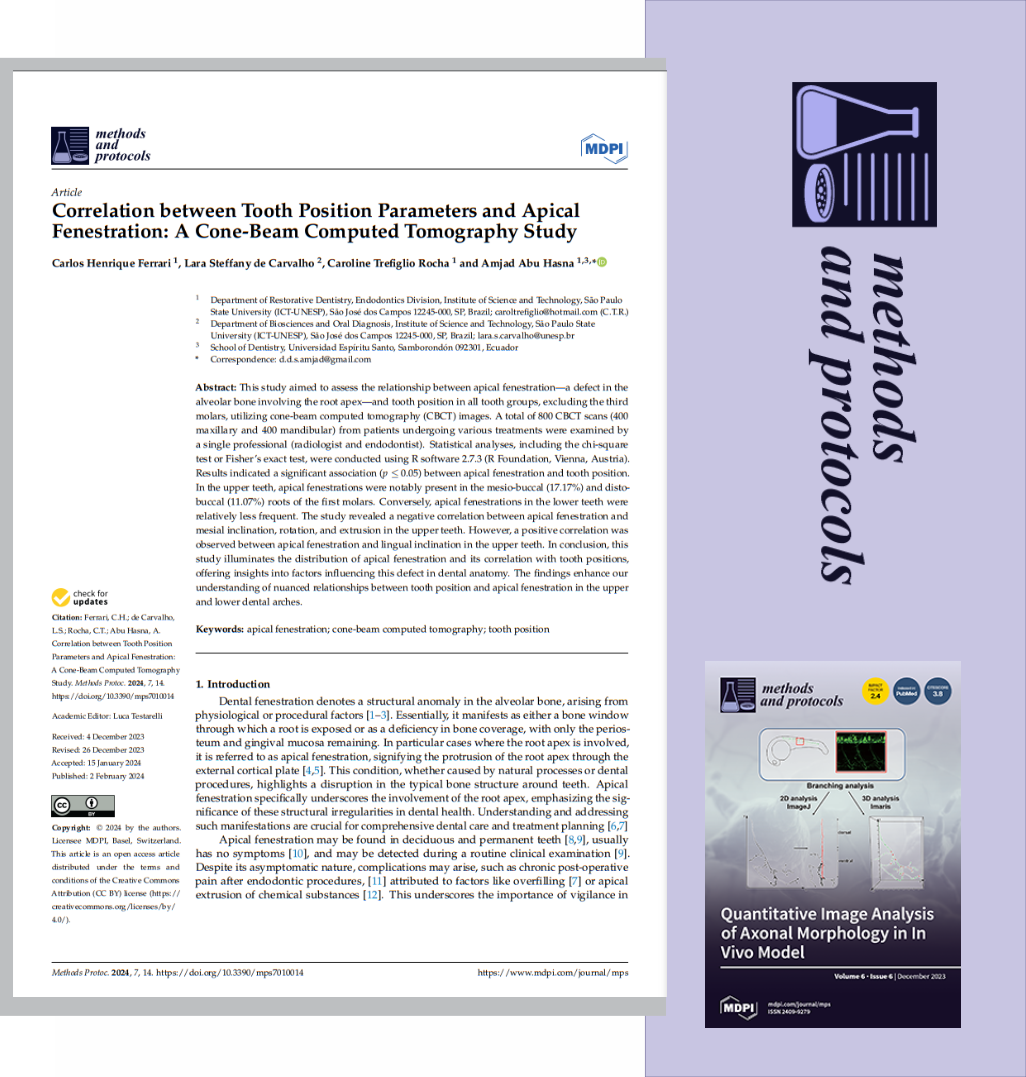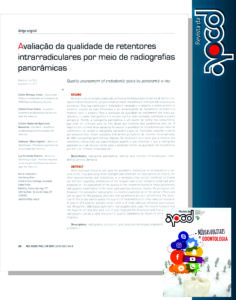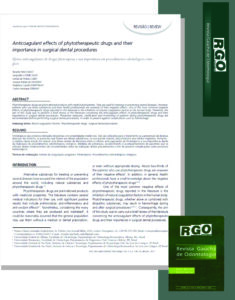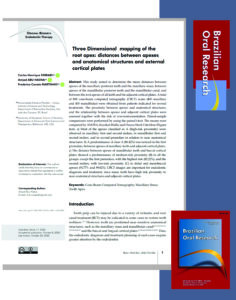Fenestração apical e posicionamentos dentais. Trabalho publicado em 2024 com o Professor Amjad Abu Hasna e a Profa. Caroline Trefiglio.
Correlation between Tooth Position Parameters and Apical Fenestration: A Cone-Beam Computed Tomography Study
Carlos Henrique Ferrari 1, Lara Steffany de Carvalho 2, Caroline Trefiglio Rocha 1 and Amjad Abu Hasna 1,3,*
1 Department of Restorative Dentistry, Endodontics Division, Institute of Science and Technology, São PauloState University (ICT-UNESP), São José dos Campos 12245-000, SP, Brazil; caroltrefiglio@hotmail.com (C.T.R.)2 Department of Biosciences and Oral Diagnosis, Institute of Science and Technology, São Paulo StateUniversity (ICT-UNESP), São José dos Campos 12245-000, SP, Brazil; lara.s.carvalho@unesp.br3 School of Dentistry, Universidad Espíritu Santo, Samborondón 092301, Ecuador* Correspondence: d.d.s.amjad@gmail.com
Abstract:
This study aimed to assess the relationship between apical fenestration—a defect in the alveolar bone involving the root apex—and tooth position in all tooth groups, excluding the third molars, utilizing cone-beam computed tomography (CBCT) images. A total of 800 CBCT scans (400 maxillary and 400 mandibular) from patients undergoing various treatments were examined by a single professional (radiologist and endodontist). Statistical analyses, including the chi-square test or Fisher’s exact test, were conducted using R software 2.7.3 (R Foundation, Vienna, Austria). Results indicated a significant association (p ≤ 0.05) between apical fenestration and tooth position. In the upper teeth, apical fenestrations were notably present in the mesio-buccal (17.17%) and distobuccal (11.07%) roots of the first molars. Conversely, apical fenestrations in the lower teeth were relatively less frequent. The study revealed a negative correlation between apical fenestration and mesial inclination, rotation, and extrusion in the upper teeth. However, a positive correlation was observed between apical fenestration and lingual inclination in the upper teeth. In conclusion, this study illuminates the distribution of apical fenestration and its correlation with tooth positions, offering insights into factors influencing this defect in dental anatomy. The findings enhance our understanding of nuanced relationships between tooth position and apical fenestration in the upper and lower dental arches.Keywords: apical fenestration; cone-beam computed tomography; tooth position1.
Introduction
Dental fenestration denotes a structural anomaly in the alveolar bone, arising from physiological or procedural factors [1–3]. Essentially, it manifests as either a bone window through which a root is exposed or as a deficiency in bone coverage, with only the periosteum and gingival mucosa remaining. In particular cases where the root apex is involved, it is referred to as apical fenestration, signifying the protrusion of the root apex through the external cortical plate [4,5]. This condition, whether caused by natural processes or dental procedures, highlights a disruption in the typical bone structure around teeth. Apical fenestration specifically underscores the involvement of the root apex, emphasizing the significance of these structural irregularities in dental health. Understanding and addressing such manifestations are crucial for comprehensive dental care and treatment planning [6,7] Apical fenestration may be found in deciduous and permanent teeth [8,9], usually has no symptoms [10], and may be detected during a routine clinical examination [9]. Despite its asymptomatic nature, complications may arise, such as chronic post-operative pain after endodontic procedures, [11] attributed to factors like overfilling [7] or apical extrusion of chemical substances [12]. This underscores the importance of vigilance in of 10dental care, as seemingly benign conditions like apical fenestration can lead to discomfort and complications, necessitating careful management during and after endodontic treatments [7].Its diagnosis is usually complicated because it may appear radiographically as a radiolucent periapical lesion [13,14], and this is related to the fact that conventional twodimensional radiography has many limitations [15]. Conversely, cone-beam computed tomography (CBCT) is a three-dimensional scanning method that produces high-resolution images and does not overlap the anatomical structures [16]. This enhances precision in evaluating small alveolar bone defects and their locations. The shift to CBCT signifies a significant improvement in diagnostic capabilities, enabling more accurate assessment of apical fenestration compared to traditional radiographic methods and thereby facilitating better-informed treatment decisions in dental care [17].Apical fenestration has many predisposing factors, including tooth position (like labial or lingual inclination of the tooth in the alveolar bone), tooth morphology, contour of the root apex, occlusal factors, and others [14,18,19]. The positioning of the tooth plays a significant role, influencing the extent of apical fenestration and diminishing the thickness of the alveolar bone [18,20]. Understanding these predisposing factors is crucial for assessing and managing apical fenestration, as they shed light on the structural considerations that contribute to this dental anomaly.This study aimed to assess the correlation between the presence of apical fenestration in all tooth groups (excluding the third molars) and tooth position (mesial inclination, lingual inclination, rotation, and extrusion) using CBCT images. The null hypothesis posits a negative correlation between the presence of apical fenestration and tooth position. The investigation focuses on elucidating potential relationships between these factors, providing valuable insights into the anatomical considerations affecting apical fenestration across various tooth groups.
Fenestração apical e posicionamentos dentais





